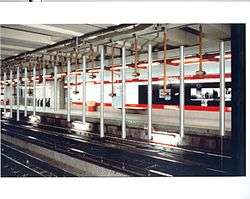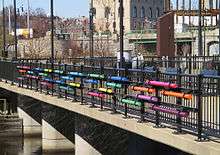Paul Matisse
Paul Matisse (born 1933) is an artist and inventor[1] known for his public art installations, many of which are interactive. Matisse also invented the Kalliroscope.
In 1954 Matisse graduated from Harvard,[2] where he once lived in Eliot House. After college he briefly studied at Harvard's Graduate School of Design before working in product development for Arthur D. Little. In 1962 he set off on his own, inventing and ultimately manufacturing Kalliroscopes.

From 1977 to 1979 he helped enlarge a sculpture by Alexander Calder (who died in 1976) for the National Gallery of Art in Washington, D.C. Thereafter, he began his own public art career.
He currently resides in a former Baptist church in Groton, Massachusetts. He is the stepson of artist Marcel Duchamp and grandson of French painter Henri Matisse. Henri Matisse's son, Pierre Matisse, was Paul's father.[2] His daughter Sophie Matisse is a painter in New York. His son, Alex Matisse, is a pottery artist and founder of East Fork Pottery in North Carolina. His granddaughter is actress Gaïa Jacquet-Matisse.
Selected public artworks


Kendall Band (1987), an interactive musical sculpture in the MBTA's Kendall/MIT subway station in Cambridge, Massachusetts

Memorial Bell for the National Japanese-American Memorial to Patriotism in Washington, DC (2001)
Charlestown Bells, an interactive musical sculpture on the Charles River Dam between downtown Boston, Massachusetts and the Boston neighborhood of Charlestown

Musical Fence (1980), an interactive musical sculpture once located in Cambridge, Massachusetts, and now housed at the DeCordova Museum in Lincoln, Massachusetts and at the Montshire Museum of Science in Vermont

Forest Bells (1997), six vertical aluminum bells hanging from the limbs of oak trees on Groton Conservation Trust property in Groton, Massachusetts
References
- ↑ http://www.paulmatisse.com/
- 1 2 Christopher Reed, "Pure Fabrications" Archived 2008-12-03 at the Wayback Machine., Harvard Magazine, May-June 2002.